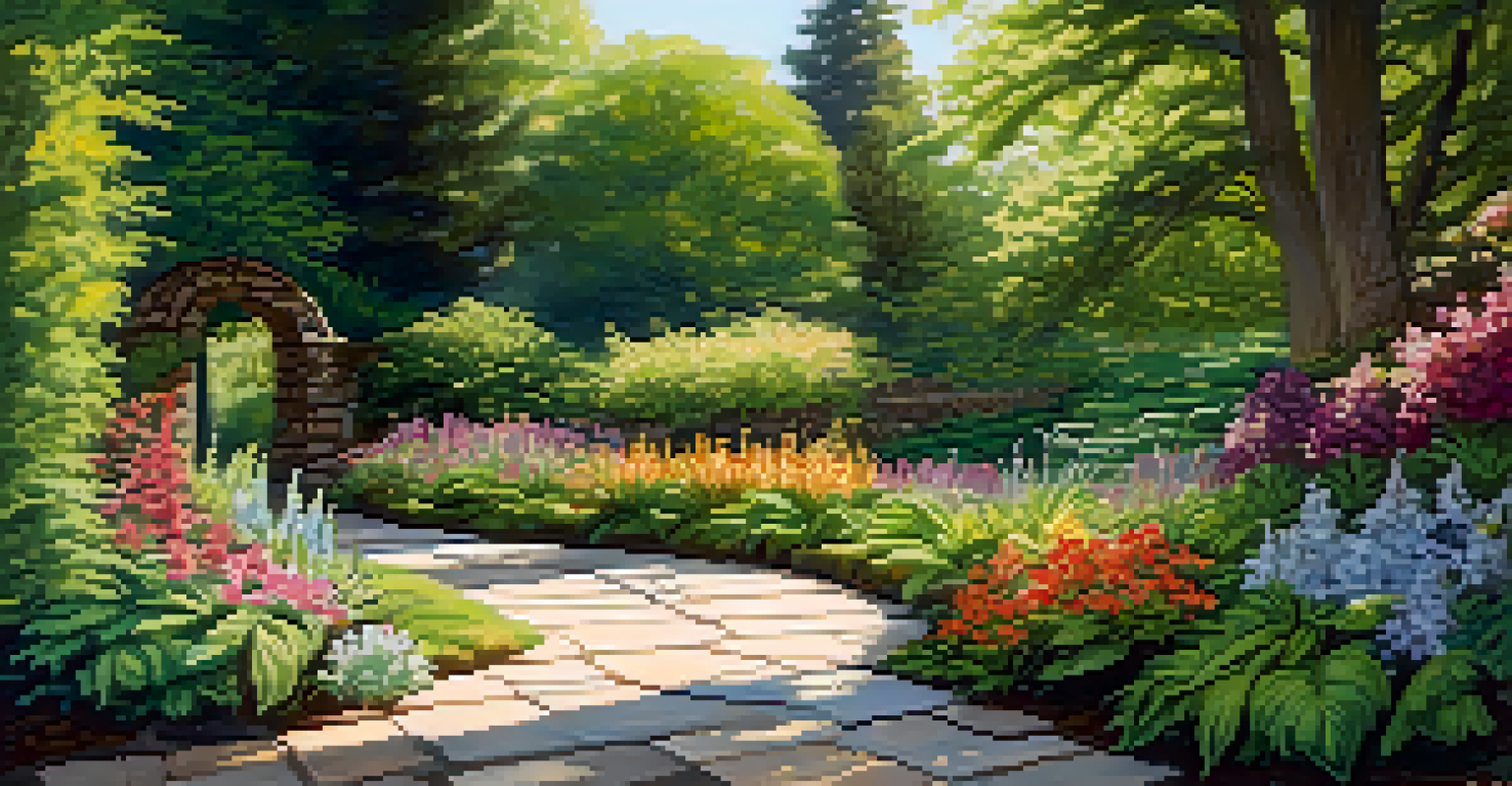The Importance of Sunlight in Sustainable Garden Design

Understanding the Role of Sunlight in Gardens
Sunlight is often considered the lifeblood of any garden. It fuels photosynthesis, the process through which plants convert light into energy, allowing them to grow and thrive. Without adequate sunlight, even the most carefully planned garden can struggle to flourish.
Gardening is a way of showing that you believe in tomorrow.
In sustainable garden design, understanding sunlight is crucial. Different plants require varying amounts of light; some thrive in full sun while others prefer partial shade. Recognizing these needs helps gardeners create balanced ecosystems that work harmoniously with nature.
Moreover, sunlight influences not only plant health but also the overall garden environment. A well-lit garden can attract beneficial insects and pollinators, which play essential roles in maintaining the ecological balance.
Choosing the Right Location for Your Garden
The location of your garden significantly affects its sunlight exposure. When selecting a site, consider factors such as tree cover, nearby structures, and even the season, as these elements can cast shadows and limit direct sunlight. Observing how sunlight moves across your space throughout the day is essential.

For instance, a garden placed on the south side of your property typically receives the most sunlight during the day, making it an ideal spot for sun-loving plants. In contrast, areas that receive morning sun and afternoon shade can be perfect for plants that prefer cooler conditions.
Sunlight Fuels Plant Growth
Adequate sunlight is essential for photosynthesis, enabling plants to thrive and maintain a healthy garden.
By thoughtfully choosing your garden's location, you can maximize sunlight exposure and create a thriving environment for your plants, ultimately enhancing the sustainability of your garden design.
Understanding Plant Light Requirements
Not all plants have the same light requirements, and this is where careful planning comes into play. Understanding whether a plant is a full sun, partial sun, or shade lover can dramatically impact the success of your garden. For example, tomatoes and sunflowers love full sun, while ferns and hostas thrive in shadier spots.
To plant a garden is to believe in tomorrow.
Mixing plants with varying light needs can lead to competition for resources, which can hinder growth. Therefore, grouping plants with similar requirements not only promotes healthy growth but also supports a more sustainable ecosystem.
Additionally, considering seasonal light changes is important. Some plants may do well in the summer sun but struggle as the days shorten in fall and winter, highlighting the need for seasonal planning in sustainable garden design.
Utilizing Sunlight for Energy Efficiency
Sustainable garden design isn't just about plants; it can also incorporate energy efficiency strategies. For instance, strategically placed trees and shrubs can provide shade for your home, reducing cooling costs during hot months. This natural shading technique effectively maximizes energy efficiency while enhancing your garden's beauty.
Moreover, using sunlight to your advantage can extend your gardening season. For example, planting cold-tolerant crops in raised beds can warm faster in spring, allowing for earlier planting. This approach not only boosts productivity but also promotes a more sustainable garden.
Location Impacts Sunlight Exposure
Choosing the right location for your garden can maximize sunlight exposure, ensuring plants receive the light they need.
By considering how sunlight interacts with your garden and home, you can design a space that is both beautiful and energy-efficient, truly embodying sustainable principles.
The Benefits of Sunlight for Soil Health
Sunlight plays a vital role in maintaining soil health, which is a cornerstone of sustainable gardening. Healthy soil supports robust plant growth and fosters beneficial microbial activity. When gardens receive adequate sunlight, soil temperatures can rise, promoting the breakdown of organic matter and enhancing nutrient availability.
Furthermore, sunlight helps to regulate moisture levels in the soil. A well-lit garden tends to dry out more quickly, which can be beneficial in preventing root rot and promoting healthier root systems. However, it's essential to balance this with proper irrigation practices to avoid drought stress.
Ultimately, maximizing sunlight exposure in your garden not only benefits plants but also contributes to healthier soil, creating a more sustainable ecosystem.
Creating Microclimates with Sunlight
Microclimates are small areas within your garden that have different climatic conditions than the surrounding environment. By understanding how sunlight interacts with your garden, you can create these beneficial microclimates. For example, a sunny spot next to a wall can be warmer than the surrounding areas, allowing you to grow plants that require more heat.
These microclimates can provide unique opportunities for gardeners. You might find that certain areas are perfect for starting seedlings earlier in the spring or extending the growing season into fall. This adaptability is key to maximizing your garden's productivity.
Microclimates Enhance Garden Variety
Creating microclimates through sunlight management allows for diverse plant growth and extends the gardening season.
Creating microclimates through sunlight management not only enhances plant health but also contributes to the overall sustainability of your garden design.
Incorporating Sunlight in Landscape Design
In sustainable garden design, incorporating sunlight into your landscape plans can greatly enhance the visual appeal and functionality of your space. For example, using pathways or seating areas that maximize sun exposure can create inviting spaces for relaxation and enjoyment. This thoughtful design approach encourages people to connect with nature.
Additionally, incorporating features such as trellises or arbors can provide both shade and aesthetic value. These structures can support climbing plants, which not only beautify your garden but also help to create vertical spaces that utilize sunlight efficiently.

A well-designed landscape that considers sunlight can enhance biodiversity by attracting various species, creating a vibrant ecosystem that thrives on the principles of sustainability.